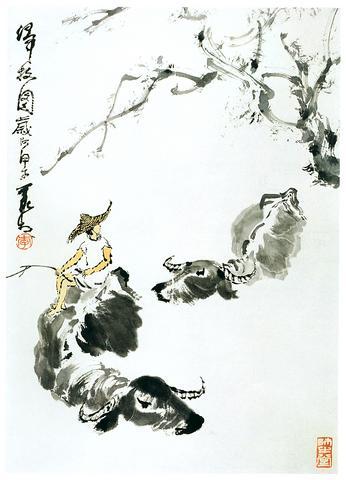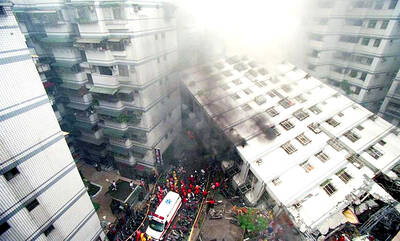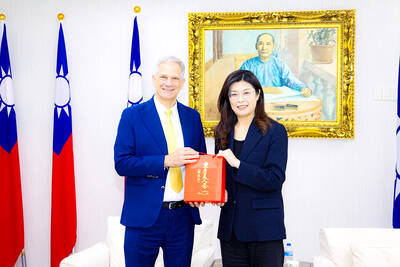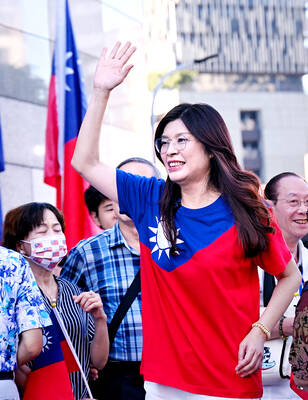Dai Dong-ni (
Over 100 originals by some 60 Chinese master painters have been gathered under one roof for viewers to appreciate up close. These include: Wu Chang-shuo's (
Dai Mei-ling (

PHOTO COURTESY OF NCA
The Changan school of paintings is one of the main categories of Dai Family's collection. Shi Lu (
Gao Chian-fu (
Fu Bao-shi (傅抱石), a well-known figure of the Chingling school, was the first painter to disregard the painting tradition of leaving blank space on the panel. His Landscape series, in which minimalist human figures appear against rugged, overwhelming cliffs, powerfully evokes the magnificence of central Chinese mountains.
Horses are Hsu Bei-hong's most celebrated subject. Hsu applied his knowledge of anatomy to painting the joints and calves of the horses and insisted on reserving one particular brush for painting the tail. These characteristics are evident in Hsu's Horse, on show at the exhibition.
Among other rare finds are Empress Dowager Zi Hsi's (
Collection of 19th to 20th Century Genuine Traditional Chinese Painting and Calligraphy will run through March 21 at National Cultural Association, 15 Chongqing S Rd., Sec 2, Taipei (

Seven hundred job applications. One interview. Marco Mascaro arrived in Taiwan last year with a PhD in engineering physics and years of experience at a European research center. He thought his Gold Card would guarantee him a foothold in Taiwan’s job market. “It’s marketed as if Taiwan really needs you,” the 33-year-old Italian says. “The reality is that companies here don’t really need us.” The Employment Gold Card was designed to fix Taiwan’s labor shortage by offering foreign professionals a combined resident visa and open work permit valid for three years. But for many, like Mascaro, the welcome mat ends at the door. A

If China attacks, will Taiwanese be willing to fight? Analysts of certain types obsess over questions like this, especially military analysts and those with an ax to grind as to whether Taiwan is worth defending, or should be cut loose to appease Beijing. Fellow columnist Michael Turton in “Notes from Central Taiwan: Willing to fight for the homeland” (Nov. 6, page 12) provides a superb analysis of this topic, how it is used and manipulated to political ends and what the underlying data shows. The problem is that most analysis is centered around polling data, which as Turton observes, “many of these

Since Cheng Li-wun (鄭麗文) was elected Chinese Nationalist Party (KMT) chair on Oct. 18, she has become a polarizing figure. Her supporters see her as a firebrand critic of the ruling Democratic Progressive Party (DPP), while others, including some in her own party, have charged that she is Chinese President Xi Jinping’s (習近平) preferred candidate and that her election was possibly supported by the Chinese Communist Party’s (CPP) unit for political warfare and international influence, the “united front.” Indeed, Xi quickly congratulated Cheng upon her election. The 55-year-old former lawmaker and ex-talk show host, who was sworn in on Nov.

Even the most casual followers of Taiwan politics are familiar with the terms pan-blue and pan-green. The terms are used so casually and commonly with the assumption that everyone knows what they mean, that few stop to really question it. The way these terms are used today is far broader and extensive than what they were originally created to represent. Are these still useful shorthand terms, or have people become so obsessed with them that they color perceptions to the point of distortion? LEE TUNG-HUI WAS NO SMURF People often assume that these terms have been around forever, or at least as